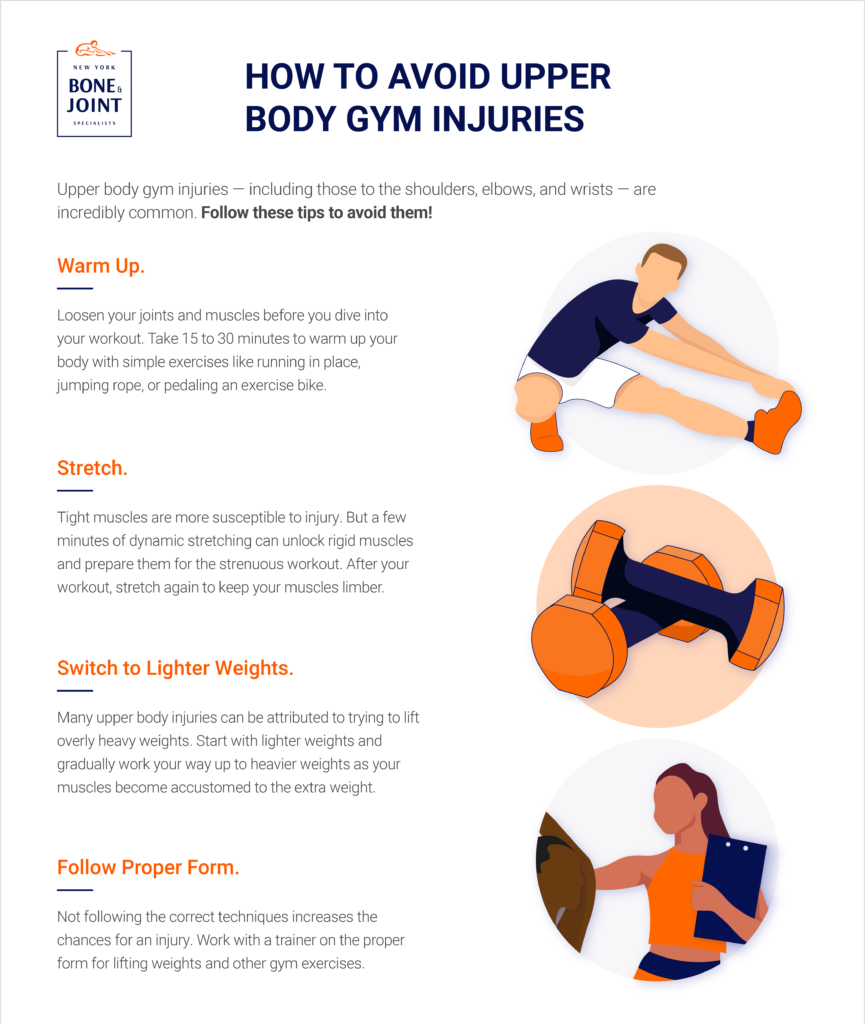Upper body gym exercises like weightlifting can sometimes damage shoulders, elbows, and wrists. Fortunately, injuries are preventable if you take precautions.
A common resolution people make — whether at New Year’s or at any other time — is to get into better shape. To accomplish that goal, many people join a gym. Working out is a great way to build muscle tone, increase stamina, and lose weight. But jumping into an intense workout without preparation can cause injuries — especially to the upper body.
Weightlifting, in particular, can carry some hidden dangers because of the extreme pressure it can put on the ligaments and muscles of your shoulders and elbows if you aren’t careful. Luckily, these injuries are avoidable as long as you stay aware of the risks and listen to your body. Read on to learn about the most common injuries to your upper body that may occur at the gym and get tips for avoiding unnecessary pain.
Common Upper Body Gym Injuries
If you experience an upper body injury at the gym, it’s most likely due to weightlifting or pull ups — areas where your shoulders and arms are doing the bulk of the work. Here’s a quick review of upper body injuries that could result from a gym workout.
Shoulder Injuries. Your shoulder is a ball-and-socket joint, held together by a network of ligaments, muscles, and tendons. It’s what allows you to move your arm in all directions, but its construction also makes it vulnerable to injury. If your shoulder isn’t accustomed to lifting heavy weights overhead, you could damage your rotator cuff (a group of tendons that attach to the long bone in the shoulder), if you aren’t careful. Repeatedly lifting a weight overhead can cause tendonitis or possibly a rotator cuff tear.
Another common shoulder injury is “weightlifter’s shoulder.” This is an injury to the acromioclavicular (AC) joint that connects the collarbone to the top of the shoulder blade. Exercises such as a bench press that require you to lower your elbows behind your shoulder stress this joint and bone, sometimes leading to inflammation of the joint.
Elbow Injuries. Pull-ups, chin-ups, and bicep curls can injure the elbow tendons, resulting in two conditions not normally associated with a gym: golfer’s elbow and tennis elbow. Golfer’s elbow, or epicondylitis, is an inflammation of the inner elbow. Meanwhile, tennis elbow is tendonitis that affects the tendon connecting the forearm muscle to the elbow joint.
Wrist Injuries. Although not as common as shoulder or elbow injuries, wrist injuries due to weightlifting are also a possibility. Lifting an extremely heavy weight can damage the ligaments holding the wrist bones together or cause stress fractures in the wrist bones. Weightlifters may also suffer from carpal tunnel syndrome, an inflammation of the median nerve spanning the length of your arm to your wrist due to overuse.
Preventing Upper Body Injuries at the Gym
Take these precautions before you workout and you’ll keep your shoulders, elbows, and wrists strong and healthy and make sure you don’t have to miss one day at your favorite gym due to an upper body injury!

Warm Up. Loosen your joints and muscles before you dive into your workout. Take 15 to 30 minutes to warm up your body with simple exercises like running in place, jumping rope, or pedaling an exercise bike.
Stretch. Tight muscles are more susceptible to injury. But a few minutes of dynamic stretching can unlock rigid muscles and prepare them for the strenuous workout. After your workout, stretch again to keep your muscles limber.
Switch to Lighter Weights. Many upper body injuries can be attributed to trying to lift overly heavy weights. Start with lighter weights and gradually work your way up to heavier weights as your muscles become accustomed to the extra weight. This is especially important if you are just starting on a gym program.
Know Your Limits. A little bit of soreness is common after a vigorous workout. But if the pain persists, consider taking a rest for a few days to give yourself time to recover. And never exercise to the point of exhaustion. Exercising when you’re fatigued will lead to injuries.
Follow Proper Form. Not following the correct techniques increases the chances for an injury. Work with a trainer on the proper form for lifting weights and other gym exercises. Once you know how to exercise safely, you’ll be able to follow the right techniques without a trainer on-hand.
Get Back in the Gym!
Have you experienced an upper body injury at the gym (or any other kind of athletic injury for that matter)? Get the help you need so you can heal and get back to the gym fast! At New York Bone & Joint Specialists, our physicians and physical therapists have helped hundreds of patients overcome shoulder and elbow injuries. We offer conservative treatments and physical therapy to resolve your pain and get your back into the gym. Contact us today for a consultation.




